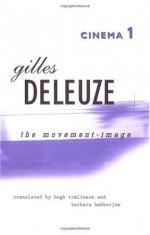|
This section contains 1,560 words (approx. 4 pages at 400 words per page) |

|
Cinematographic illusion
Cinematographic illusion is the term Bergson uses to describe his idea that movement occurs in the interval between spaces and is not separate from space
Phenomenology
Phenomenology is the term used to describe the philosophical study of how things appear. In this work, Deleuze assumes natural perception is qualitatively different from cinematographic perception.
Marey and Muybridge's Galloping Horse
Marey and Muybridge's galloping horse is the term that describes a phenomenon when one, three, two and one hooves of a galloping horse seem to hit the ground.
Privileged Instants
Privileged instants are the terms used for the regular, singular, ordinary or remarkable organized set of any-instant-whatevers that survive cutting per Eisenstein. These instants are unique to movement, as Marey and Muybridge's galloping horse, and cannot be posed or captured with a camera's long exposure.
Duration
Duration is a term used to describe consciousness which is open upon...
|
This section contains 1,560 words (approx. 4 pages at 400 words per page) |

|




